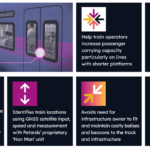In the second of two guest writer features on innovation, David Muse, Chief Technical Architect at Petards Rail, discusses the barriers – and explains how rail organisations can overcome them, all while learning from other sectors.
At Petards Rail, our focus is delivering cutting-edge projects within the rail industry, an environment that demands precision and innovation. My team and I have successfully rolled out multiple high-level projects, each contributing significantly to the advancement of rail technology and safety. I’m particularly proud of our latest solution – an Automatic Selective Door Operation (ASDO) system.
Innovation is key to the progress and competitiveness of the rail industry – but a range of barriers can impede its pace and implementation. Understanding these barriers and finding ways to overcome them is essential.
Below, I’ll outline six barriers to innovation, and propose solutions.
Slow contract awards
In the UK rail industry, the process of awarding contracts for infrastructure projects, technology upgrades, or other services can be slow due to bureaucratic procedures, extensive regulatory requirements, and the need for thorough evaluation processes. This delay can hinder the timely implementation of innovative solutions.
Solution: Streamlining procurement, adopting more agile contracting methods, and setting up specialised committees or task forces to expedite decision-making can help – as can fostering closer collaboration between the rail industry and government regulatory bodies.
Regulatory compliance
The rail industry is heavily regulated, and new technologies or methods must undergo rigorous testing and approval processes, which can be time-consuming and costly.
Solution: Working closely with regulatory bodies during the development phase can ensure compliance from an early stage and potentially expedite the approval process.
Resistance to change
There can be cultural resistance to change within organisations, particularly in industries like rail, which has a long history and established ways of doing things.
Solution: Education and training programmes can help staff understand and embrace new technologies. Involving employees in the innovation process and demonstrating clear benefits can also reduce resistance.
Technological complexity
Modern technologies, especially those involving AI, big data, and Internet of Things (IoT), can be complex and require specialised knowledge.
Solution: Investing in employee training and hiring or collaborating with tech experts can help rail companies better understand and integrate these technologies.
Integration with existing infrastructure
Integrating new technologies with existing rail infrastructure can be challenging, especially if the infrastructure is old or not designed for modern technology.
Solution: Phased implementation plans, where new technologies are gradually integrated, and the use of modular or adaptable technologies can ease this transition.
Cybersecurity risks
As the rail industry adopts more digital solutions, the risk of cyber-attacks increases.
Solution: Investing in robust cybersecurity measures and continuously updating them is essential to protect against these risks.
By addressing these barriers, the rail industry can create a more conducive environment for innovation. This, in turn, will lead to improved efficiency, safety, and customer satisfaction. Stakeholder collaboration, strategic planning, and continuous investment in technology and skills are key to overcoming the challenges I’ve outlined.
Learning from other industries
And, when it comes to innovation, there’s much the rail industry can learn from other transport modes. The automotive sector’s advancements in autonomous driving technology can be adapted for autonomous train systems, while aerospace’s sophisticated predictive maintenance models (using data analytics to anticipate maintenance needs) reduce downtime and extend the life of rail assets.
Rail also has lessons to learn from the tech industry, which uses IoT technologies for real-time monitoring and data collection. This strategy can enhance both operational efficiency and the passenger experience.
Developing Petards Rail’s Automatic Selective Door Operation (ASDO) system
As well as looking to other sectors, Petards Rail works closely with key rail industry players – from the Rail Safety and Standards Board (RSSB), train operating companies (TOCs), and rolling stock companies (ROSCOs), to train builders and the British Transport Police. This collaborative approach helps us to understand the multifaceted needs of the rail industry and overcome potential barriers. It was also key to the success of our ASDO solution.
Originally developed for a specific project in collaboration with a rail operator, this innovative ASDO system was soon extended and optimised for a second project with a different TOC. Innovation is an ongoing process – and, over the current service life of the system, continuous improvements have been made to enhance its functionality and reliability.
One such improvement was its expansion to include Correct Side Door Enabled (CSDE) operation, which allows for more comprehensive safety and operational management.
Modularity was also a key concern, and the ASDO system was designed to fit seamlessly within the broader Petards Rail eyeTrain product range. We prioritised easy integration with other eyeTrain products (including Driver Controlled Operation (DCO) and Automatic Passenger Counting (APC)). This simplifies installation and maintenance processes, and allows for the development of scalable solutions.
It also means that TOCs can deploy ASDO flexibly with other eyeTrain products, creating a cohesive and comprehensive onboard safety and monitoring system. For instance, integrating ASDO with CCTV provides enhanced surveillance capabilities, while coupling it with DCO and APC can improve operational control and passenger management.
Today, the ASDO system is in active service. It has been instrumental in the operation of the UK’s best-performing train fleet over the last three years, significantly contributing to its safety and efficiency.
This progression from an initial project-specific development to a widely implemented and continuously optimised system highlights the ASDO’s significance in the rail industry. And its impact on train operations and passenger safety is testament to the power of innovation. The barriers can be significant – but they are not insurmountable.
For more information, visit https://petardsrailsolutions.com/.
To download Petards Rail’s new ASDO system brochure, click here.

